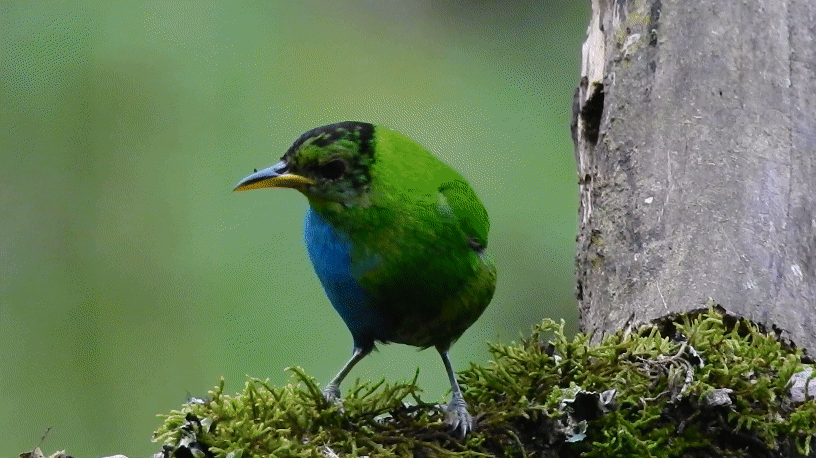This ‘Extremely Rare’ Bird Is Half Female, Half Male
The green honeycreeper is only the second of its species ever observed with this condition—and the first recorded in more than 100 years

Researchers have spotted an “extremely rare” green honeycreeper in Colombia that’s half female and half male. The bird’s plumage is divided directly down the middle, with blue feathers typical of males on its right side and the emerald-green feathers of females on its left. This individual is only the second of the species ever recorded exhibiting this trait—called bilateral gynandromorphism—and the first in more than 100 years.
“Many birdwatchers could go their whole lives and not see a bilateral gynandromorph in any species of bird. The phenomenon is extremely rare in birds. I know of no examples from New Zealand, ever,” Hamish Spencer, a zoologist at the University of Otago in New Zealand who witnessed the bird while on vacation, says in a statement. “It is very striking. I was very privileged to see it.”
Bilateral gynandromorphism occurs in a variety of species—including spiders, butterflies, crustaceans and lizards—though it’s never been recorded in humans. In humans, biological sex is usually determined by our chromosomes. Those born female typically have two X chromosomes, while those born male tend to have an X and a Y chromosome. Birds are the opposite. Their chromosomes are designated as Z and W—females have a Z and a W, while males have two Z chromosomes.
Gynandromorphism could occur if a bird produced a single egg with two nuclei—one with a Z and one with a W chromosome—that becomes “double fertilized” by two sperm with Z chromosomes, Arthur Arnold, a researcher at the University of California, Los Angeles, told the New York Times’ Karen Weintraub in 2019.
Amateur ornithologist John Murillo initially spotted the bird—then, between October 2021 and June 2023, he, Spencer and their colleagues observed the animal on multiple occasions and recently published their findings in the Journal of Field Ornithology. The green honeycreeper appeared to behave as any other member of its species, though it was more of a loner and did not display any courtship behavior or pairing. The researchers “strongly suspect it did not reproduce,” they write.
/https://tf-cmsv2-smithsonianmag-media.s3.amazonaws.com/filer_public/75/23/75231ab5-7a38-4e4d-bfa9-5142d224a5b1/bilaterally-gynandromorphic-green-honeycreeper-image-940-wide.jpg)
The scientists never captured the bird, so they don’t know whether its internal organs were also split male-female down the middle of its body. However, “that would be expected,” they write, because birds’ sex organs develop based on their cells’ chromosomes rather than body-wide hormones. And studies of other bilaterally gynandromorphic songbirds have revealed both sex organs, per the authors.
Studying gynandromorphic individuals could provide scientists a window into how birds’ sex determination works—a process that is still poorly understood in humans. Though researchers have known that chromosomes influence biological sex, much remains mysterious about the specific genes that control sexual development. Many biologists agree that dividing species into just the binary male and female is “overly simplistic,” because a wide variety of traits typically considered male or female—such as chromosomes, sex organs and sex hormones—can be combined in different ways.
In humans, for example, some people have XXY chromosomes, just one X chromosome or XX chromosomes in some cells and XY in others. Some develop genitalia typically associated with females, despite having chromosomes typically associated with males.
Elsewhere in the animal kingdom, species exist that can change sexes or express multiple sexes simultaneously. Last year, a charity in the United Kingdom helped a gender-neutral kitten with no sex organs to get adopted.
Spencer says in the statement he hopes the green honeycreeper will help people “treasure exceptions.”
“I hope [this finding] stimulates birders everywhere to keep an eye out for any unusual sightings, especially gynandromorphy,” Spencer tells Newsweek’s Robyn White.
/https://tf-cmsv2-smithsonianmag-media.s3.amazonaws.com/accounts/headshot/MargaretOsborne.png)
/https://tf-cmsv2-smithsonianmag-media.s3.amazonaws.com/accounts/headshot/MargaretOsborne.png)